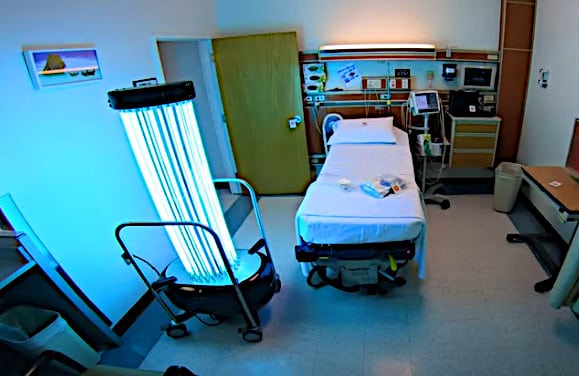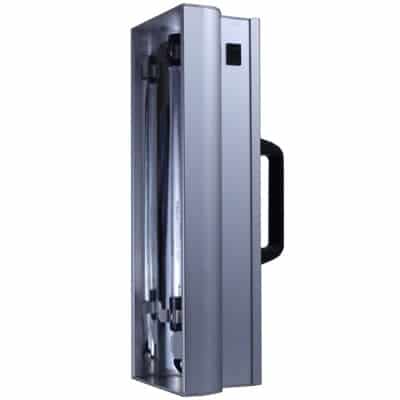
UVC UV-C Antibacterial Solutions
This is our general synopsis page of UV Resources and information.
UV-C Antibacterial Light
Another antibacterial tool is UV-C light. It however has many cautions.
UV-C News
- 12/15 Retail automation gets UV robot for disinfecting retail and hospitality venues. LG to show at Digital CES 2021 coming up.
- 08/23 — Article on UV-C Wands from CNET. The dangers of. LINK
What Are Germicidal Lamps?
Germicidal lamps emit radiation in the UV-C portion of the ultraviolet (UV) spectrum, which includes wavelengths between 100 and 280 nanometers (nm). The lamps are used in a variety of applications where disinfection is the primary concern, including air and water purification, food and beverage protection, and sterilization of sensitive tools such as medical instruments. Germicidal light destroys the ability of bacteria, viruses, and other pathogens to multiply by deactivating their reproductive capabilities. The average bacteria may be killed in 10 seconds at a

The Blade features an on/off safety switch, and a comfortable handle that minimizes grip discomfort.
Hazard and Risks from Germicidal Lamp UV Radiation
UV radiation (UVR) used in most germicidal bulbs is harmful to both skin and eyes, and germicidal bulbs should not be used in any fixture or application that was not designed specifically to prevent exposure to humans or animals. UVR is not felt immediately; in fact, the user may not realize the danger until after the exposure has caused damage. Symptoms typically occur 4 to 24 hours after exposure. The effects on skin are of two types: acute and chronic. Acute effects appear within a few hours of exposure, while chronic effects are long-lasting and cumulative and may not appear for years. An acute effect of UVR is redness of the skin called erythema (similar to sunburn). Chronic effects include accelerated skin aging and skin cancer. UVR is absorbed in the outer layers of the eye – the cornea and conjunctiva. Acute overexposure leads to a painful temporary inflammation, mainly of the cornea, known as photokeratitis. Subsequent overexposure to the UV is unlikely because of the pain involved. Chronic exposure leads to an increased risk of certain types of ocular cataracts. Working unprotected for even a few minutes can cause injury. It is possible to calculate the threshold for acute effects and to set exposure limits. It is not possible, however, to calculate threshold for chronic effects; therefore, because no exposure level is safe, exposure should be reduced as much as possible.
UV-C Handheld Blade FAQ
- How does one use it?
With the Blade unit, all you need to do is get it as close to the surface as possible and pass it over the surface. Being one inch away, a few seconds exposure kills all bacteria and virus.
- How long does it take?
Some take a little longer than normal but a few seconds is plenty if 1 inch away
- What is the wrong way to use them?
You don’t shine the light up or at anyone and the operator should wear safety glasses which we include with every unit
- How does it handle oily fingerprints and smudges?
The surface should be wiped down for the best application
- These should be used in off-hours when no customers or patients around? Example: the front lobby of VA where check-in’s are taking place.
They can be used 24 hours a day, you just need to have people stand back while you run the unit over the surface
UV-C Resources
- Germicidal lamp safety tips
- Hazards of UV – University of Vermont
- UV Light Technology in UK
- American Ultraviolet
- Hand held UV-C application
- STERIL-AIR TODAY provides proven ultraviolet disinfection technology to American entrepreneurs without any upfront costs to help them reopen safely.
- Picture and article on UV-C Award
- Room Treatment — VidaShield UV air filtrations in every room/operatory, check them out at https://vidashield.com/. These rid the air of all bacteria, fungi and viruses every 15 minutes during business hours. There are HVAC mirrors with high-speed suction which will reduce aerosols during treatment along with the Isolite system, which dental offices have always used if needed during treatment.
- CNN Health 4/26/2020 — article link –If sunlight kills coronavirus, why not try UV lamps?
From Our Award Article – Link
Last Updated on
Editors Note: Back in 2016, four years ago, we were given an award for developing UV-C technology embedded in a patient check-in kiosk. We looked at many potential solutions, and the final two candidates were UV-C and Copper. Copper has some real advantages, and it has the data and the approvals to go along with it. Like any other solution, though, it has its disadvantages. It kills bacteria, but the rate of kill is slower. It is safer, but it is more expensive. A targeted, comprehensive approach to battling bacteria is the best approach. In the end, for the kiosk, UV-C was the clear winner.
The question might be why were more not sold then. Good question. And we think the answer is again, a combination of factors. The two primary ones are 1st; there was no subsequent independent lab testing. That costs money, and a small company must be frugal—secondly, the cost premium. Too often, customers, even those in the public health sector, see the least price, and make the short term cheaper selection.
Four years later, they are maybe adding all types of antibacterial protection, and issuing press releases how they are “now” better serving their patients. They could have been sending out PRs that from the get-go, they have always cared. Plus they would’ve saved the additional money. And likely, fewer patients might have been infected at the hospital.
For a full wrap on antibacterial solutions, including Copper and UV-C, see the main Antibacterial page here onsite. We’ve included at the bottom of the article below, the useful UV-C links.
Our recommendations for these technologies at the current time?
- Copper plodding on fixtures, handles in facilities is a good idea
- Spot cleaning with handheld UV-C during maintenance cycles is good
- There are now UV-C systems for ceiling lights which sanitize the air in the room (think sitting in a dentist office or chair e.g.)
The following is the originally posted press release from 4 years ago.
